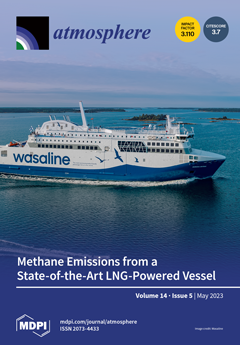This study presents the source apportionment of coarse-mode particulate matter (PM
10) extracted by 3 receptor models (PCA/APCS, UNMIX, and PMF) at semi-urban sites of the Indian Himalayan region (IHR) during August 2018–December 2019. In this study, water-soluble inorganic ionic species (WSIIS),
[...] Read more.
This study presents the source apportionment of coarse-mode particulate matter (PM
10) extracted by 3 receptor models (PCA/APCS, UNMIX, and PMF) at semi-urban sites of the Indian Himalayan region (IHR) during August 2018–December 2019. In this study, water-soluble inorganic ionic species (WSIIS), water-soluble organic carbon (WSOC), carbon fractions (organic carbon (OC) and elemental carbon (EC)), and trace elements of PM
10 were analyzed over the IHR. Nainital (62 ± 39 µg m
−3) had the highest annual average mass concentration of PM
10 (average ± standard deviation at 1 σ), followed by Mohal Kullu (58 ± 32 µg m
−3) and Darjeeling (54 ± 18 µg m
−3). The annual total ∑WSIIS concentration order was as follows: Darjeeling (14.02 ± 10.01 µg m
−3) > Mohal-Kullu (13.75 ± 10.21 µg m
−3) > Nainital (10.20 ± 6.30 µg m
−3), contributing to 15–30% of the PM
10 mass. The dominant secondary ions (NH
4+, SO
42−, and NO
3−) suggest that the study sites were strongly influenced by anthropogenic sources from regional and long-range transport. Principal component analysis (PCA) with an absolute principal component score (APCS), UNMIX, and Positive Matrix Factorization (PMF) were used for source identification of PM
10 at the study sites of the IHR. All three models showed relatively similar results of source profiles for all study sites except their source number and percentage contribution. Overall, soil dust (SD), secondary aerosols (SAs), combustion (biomass burning (BB) + fossil fuel combustion (FFC): BB+FFC), and vehicular emissions (VEs) are the major sources of PM
10 identified by these models at all study sites. Air mass backward trajectories illustrated that PM
10, mainly attributed to dust-related aerosols, was transported from the Thar Desert, Indo-Gangetic Plain (IGP), and northwestern region of India (i.e., Punjab and Haryana) and Afghanistan to the IHR. Transported agricultural or residual burning plumes from the IGP and nearby areas significantly contribute to the concentration of carbonaceous aerosols (CAs) at study sites.
Full article





